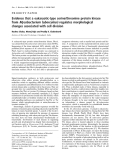
72
Journal of Medicine and Pharmacy, Volume 13, No.04, June-2023
Corresponding author: Nguyen Thi Binh Nguyen, email: ntbnguyen@huemed-univ.edu.vn
Ngo Viet Quynh Tram, email: nvqtram@huemed-univ.edu.vn
Recieved: 22/2/2023; Accepted: 4/3/2023; Published: 10/6/2023
Application of the real-time PCR Taqman allelic discrimination
assay for the detection of Isoniazid and/or Rifampicin resistant
Mycobacterium Tuberculosis from clinical samples
Nguyen Thi Binh Nguyen1*, Tran Thi Hong Van1, Nguyen Thi Kieu Diem2, Truong Van Hue3,
Tran Tuyet Ngoc4, Phan van Bao Thang4, Nguyen Thi Tuyen4, Nguyen Hoang Bach4,
Mai Van Tuan5, Paola Molicotti6, Ngo Viet Quynh Tram4*
(1) Infectious Diseases and Tuberculosis Dept., Hue University of Medicine and Pharmacy, Hue University, Vietnam
(2) Da Nang Lung Hospital, Da Nang, city, Vietnam
(3) Central Hospital 71, Thanh Hoa province, Vietnam
(4) Microbiology Department, Hue University of Medicine and Pharmacy, Hue University, Vietnam
(5) Microbiology Department, Hue Central Hospital, Vietnam
(6) Department of Biomedical Science, Microbiology and Clinical Microbiology, University of Sassari, Italy
Abstract
Background: Drug-resistant Tuberculosis (DR-TB) is challenging public health problem in countries with
high tuberculosis prevalence and limited resources. Developing and applying the most appropriate and
effective methods for diagnosing DR-TB from clinical samples is necessary, allowing a more rapid detection
method for large-scale screening. Methods: Applying real-time PCR Taqman allelic discrimination with a
PCR Taqman probes panel to identifying the DR-TB associated mutations in rpoB and katG of Mycobacterium
Tuberculosis from isolates and clinical samples. Results: Comparing results of the real-time PCR allelic and
DNA sequencing results, the sensitivity and specificity for Isoniazid resistance detection by analysing katG
were found 95% (75.1 - 99.8) and 100%, Rifampicin resistance determining region (RRDR) of rpoB were found
95.5 (77.16 - 99.88) and 100%, respectively. The real-time PCR TaqMan allelic discrimination also showed the
sensitivities 100% for both katG and rpoB, and the specificities were 93.55% (78.58 - 99.21) for the rpoB and
93.94% (79.77 - 99.26) for the katG from clinical samples. Conclusions: This study showed that the real-time
PCR taqman allelic discrimination assay is useful for detection of TB and DR-TB because of an accurate and
rapid diagnosis in the early stages.
Key words: drug-resistant, Tuberculosis, clinical samples, real-time PCR taqman allelic discrimination
assay, Mycobacterium tuberculosis.
1. INTRODUCTION
Tuberculosis (TB) is an old infectious disease
caused by Mycobacterium tuberculosis (M.
tuberculosis), but nowadays, it still remains a burden
on the global health system by the uncontrolled rise of
drug-resistant tuberculosis (DR-TB) [1], [2]. In 2020,
according to WHO estimated 10.4 million patients
with TB and 1.5 million deaths were attributed
to this disease. Currently, Vietnam is ranked 13th
position among the 30 countries with the most cases
of drug-resistant TB prevalence in the world [3], [4].
It was estimated that 40% of TB patients were not
diagnosed and treated each year in Vietnam [5],
empirical treatment increased DR-TB at hospitals [6].
In central Vietnam, only one Clinical microbiological
laboratory of Danang Lung Hospital performed DST
detecting DR-TB by BACTEC MGIT system, molecular
DST methods as the GeneXpert MTB/RIF and LPA
are rapid results, reduced the turn-around time.
However, these methods require costly reagents,
sophisticated quipment. The diagnosis, treatment,
and management of DR-TB are significant challenges
for Vietnam National Tuberculosis Control Program
[7]. Moreover, there are limited genetic studies that
characterize genotype of M. tuberculosis isolates
in central Vietnam. So, the insights that emphasize
and thorough understanding of the genotypic DR-
TB isolates are assisted in focusing on infection
control and surveillance to prevent new cases of
DR-TB in this region. Development of new rapid
molecular tests for screening drug resistant TB
and evaluation for application in clinical settings
has been done during recent years [8], [9]. In this
study, we performed the real-time PCR TaqMan
allelic discrimination assay, that MTB drug-resistant
strains can be detected by pattern’s curve or Cycle
Threshold (Ct) with three TaqMan probes without
MGB in real-time PCR based on previous researches
DOI: 10.34071/jmp.2023.4.10





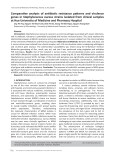
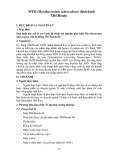
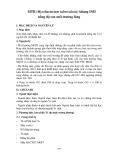

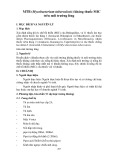
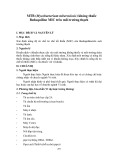
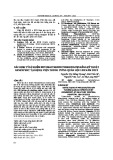
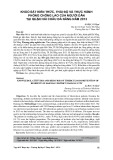

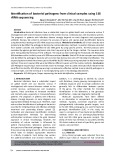
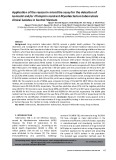
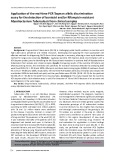

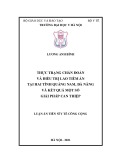
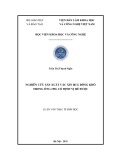
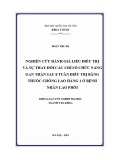
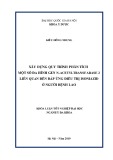
![Synthesis and anti-tuberculosis studies of 10-phenyl sulfonyl-2-alkyl/aryl- 4, 10 dihydrobenzo [4, 5] imidazo [1, 2-a] pyrimidin-4-one derivatives](https://cdn.tailieu.vn/images/document/thumbnail/2020/20200525/tocectocec/135x160/3621590394727.jpg)

